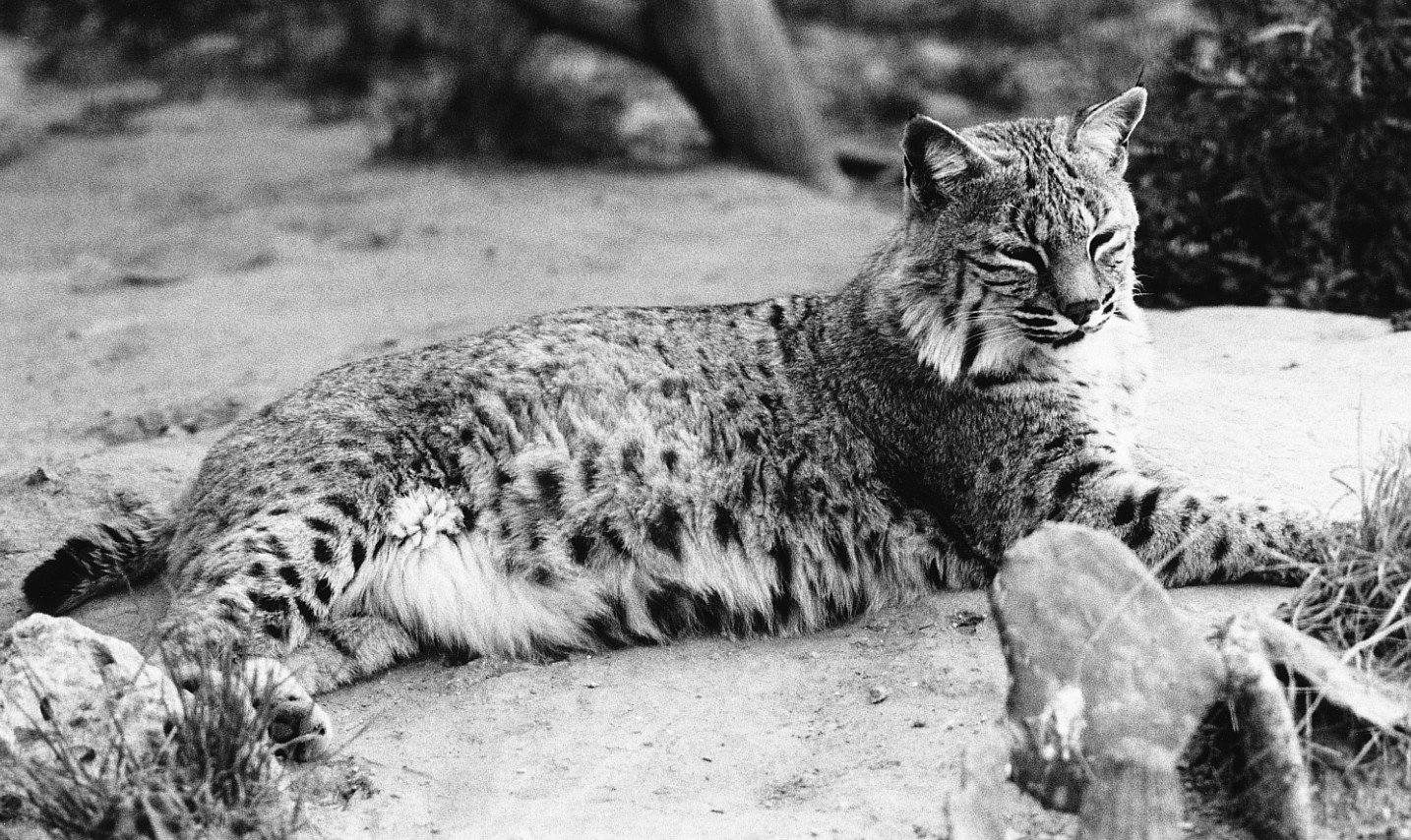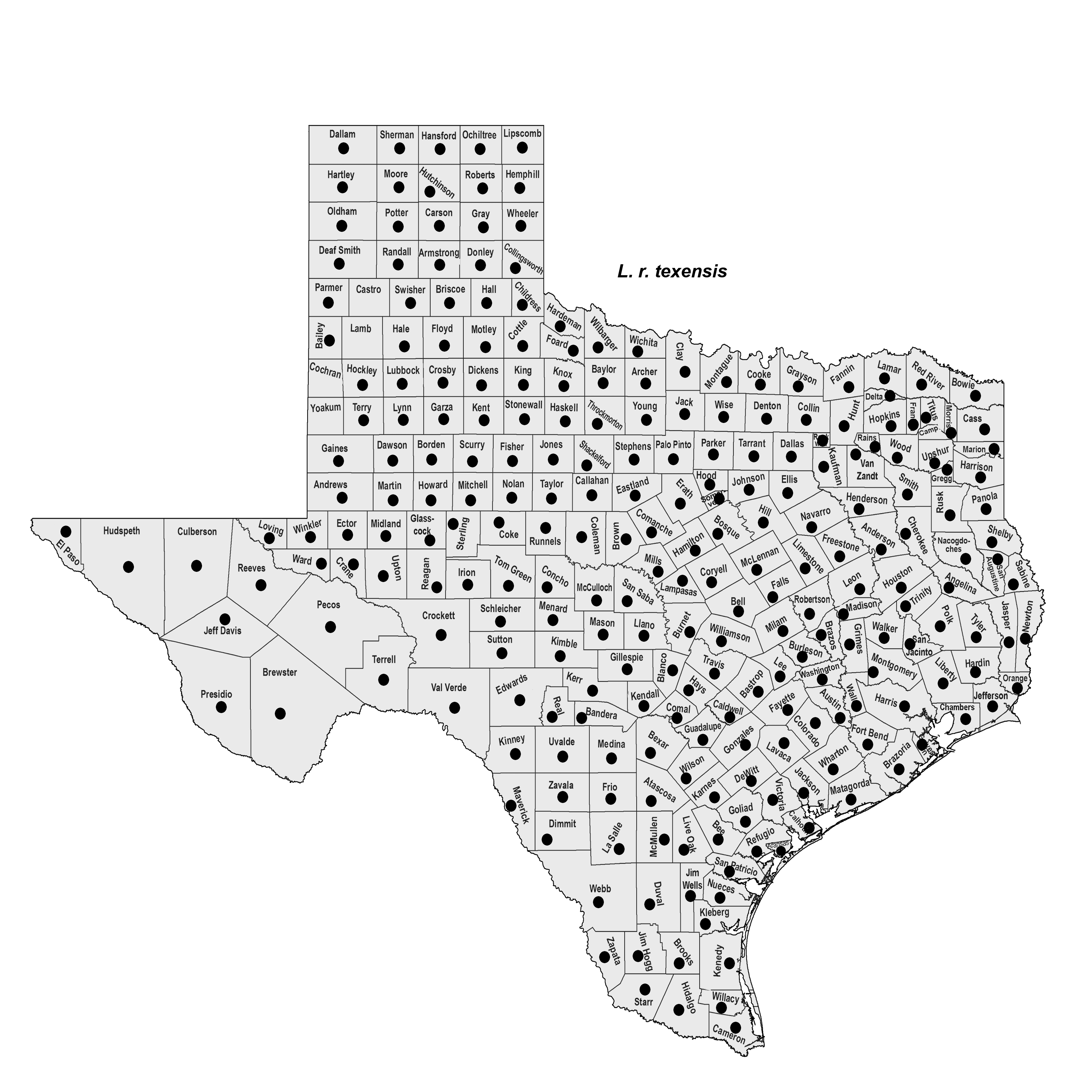BOBCAT
Lynx rufus (Schreber 1777)
Order Carnivora : Family Felidae
DESCRIPTION. A medium-sized, short-tailed, reddish-brown or grayish cat; upperparts reddish brown, streaked with black; underparts whitish, spotted with black; back of ears black rimmed with white in center; ears usually slightly tufted; hair on sides of head long, producing a ruff; pelage elsewhere rather short; tail usually shorter than hind foot, the tip black above and white below, with three or four blackish bars above just in front of tip; legs relatively long; feet large, with five toes in front, four behind. Dental formula: I 3/3, C 1/1, Pm 2/2, M 1/1 × 2 = 28. Averages for external measurements: of males, total length, 870 mm; tail, 146 mm; hind foot, 171 mm; of females, 772-144-158 mm. Weight of adults, 5–9 kg, occasionally as much as 16 kg in old animals.

DISTRIBUTION. The bobcat is widely distributed over most of the United States and occurs throughout Texas. It mainly inhabits wooded and broken country but sometimes occurs on the plains region. It is well known in the Pineywoods of eastern Texas, showing a preference for heavily wooded uplands and bottomland forests, especially second-growth timber. It also occurs in the rocky limestone region of the Edwards Plateau and is common in parts of southern and western Texas where brush has spread over the former plains. The bobcat is fairly common throughout the Trans-Pecos, where it shows a decided preference for rocky canyons, gulches, and cliffs. However, the bobcat is a habitat generalist, capable of using agricultural and urban areas, particularly where there is adequate cover.

SUBSPECIES. Lynx r. texensis.
HABITS. Bobcats are mainly active at night but may begin hunting long before sundown. During the day, they stay in a rest shelter located in a thicket, a standing or fallen hollow tree, or a rocky cliff crevice. They are active year-round and do not hibernate.
Bobcats may travel 3–8 km (2–5 mi.) each night in their hunting forays, but the exact size of their home range depends on prey availability, season of the year, breeding season, and overall quality of the available habitat. Bobcats frequently hunt from roads and trails. They depend on their keen sense of eyesight and hearing to detect prey, and hunting skill is strongly related to experience. Their usual method of procuring prey is to stalk and pounce on it, but sometimes they ambush prey along cattle and wildlife trails.
Bobcats primarily are carnivorous, although they occasionally eat grass. Rabbits are by far their most important food, followed by squirrels, rats, and mice. Fawns are often consumed in the summer months and adult deer, mostly carrion, is sometimes consumed in autumn and winter following deer hunting season. Minor items in their diet include birds, and they occasionally consume quail. Domestic animals, particularly chickens and other fowl, are sometimes consumed.
Breeding activity reaches a peak in February and March, but some breeding may occur as early as November and as late as July. The major months of birth are April and May, and young may be born as early as January or as late as September. The litter, which ranges in size from one to five (average 2.7), is born following a gestation period of about 62 days. Nutrition and drought play an important role in the reproductive process of bobcats. At times of nutritional stress, reproductive activities may be reduced and abortion or embryo resorption may occur.
The young are born well furred and spotted, with their eyes closed, in a den located in dense woody cover. They are weaned at about 2 months of age and generally are able to fend for themselves by 6 months. Family ties are not generally broken until the female mates and becomes pregnant again. Females do not breed during their first year, but they may mate successfully between their first and second years and continue doing so until they are at least 8 or 9 years of age. Bobcats are fairly long-lived animals. Individuals 12–13 years of age have been reported in the wild, and a significant portion of the population may be older than 6 years. Mortality is high among juveniles, then decreases to a low level at 5 years, and gradually increases again. Automobiles are one of the most important sources of mortality. Coyotes also will kill the young.
POPULATION STATUS. Common. Unlike the other wild cats of Texas, the bobcat is highly adaptable and in most areas has coped well with human settlement. A concern did develop in the 1970s because of high harvest levels by fur trappers. It was concluded that populations might have been overharvested in some local areas and that the illegal transport of pelts from Mexico to Texas might have contributed to high harvest densities in some border counties. At present, bobcats are doing well throughout much of the state.
CONSERVATION STATUS. The IUCN lists the bobcat as a species of least concern, and it does not appear on the federal or state lists of concerned species. Bobcats are considered the second most valuable fur-bearing species in the state with 54,159 trapped between 2000 and 2013. Currently, the most serious threat to this species is becoming roadkill because of vehicular traffic.
From The Mammals of Texas, Seventh Edition by David J. Schmidly and Robert D. Bradley, copyright © 1994, 2004, 2016. Courtesy of the University of Texas Press.
Natural Science Research Laboratory
-
Address
Museum of Texas Tech University, 3301 4th street, Lubbock, TX 79409 -
Phone
806.742.2486 -
Email
nsrl.museum@ttu.edu

